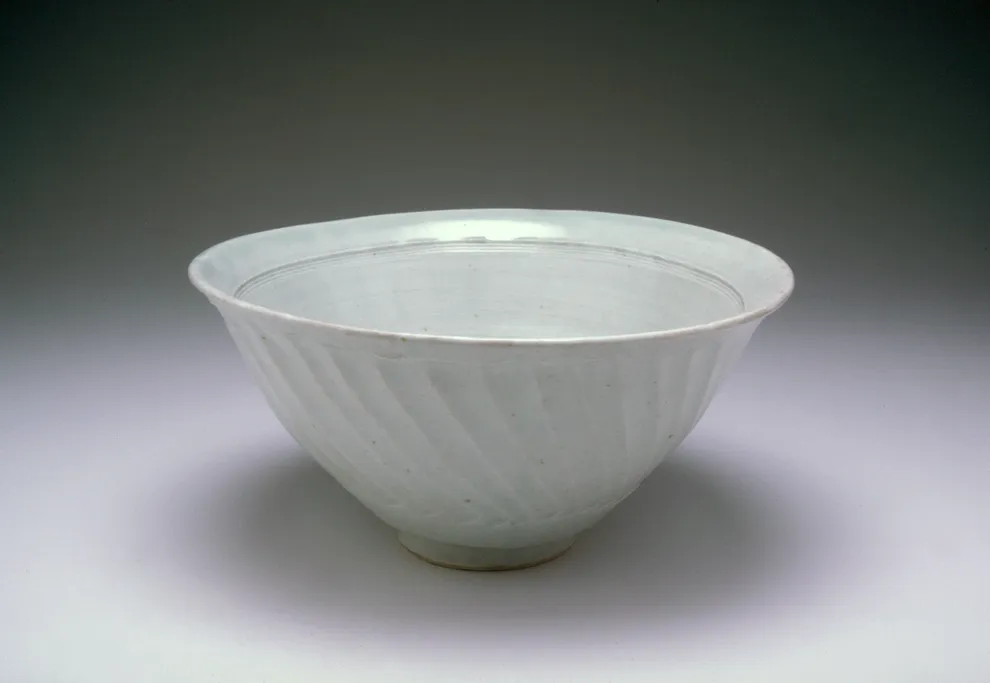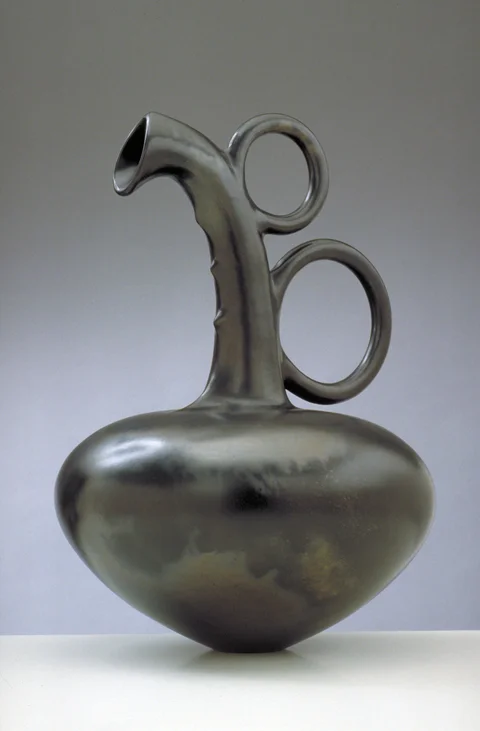Ceramic art flourished in Britain during the 20th century, changing the face of clay forever. Pioneering potters began to work independently, using an ancient craft to create cutting-edge art and design. Here’s our pick of the UK’s top ceramic artists from the century – some of whom are still alive and making – that we think you should know.


Fluted bowl by Bernard Leach, porcelain with Ying Ch'ing glaze, 1960-65. Photo: Crafts Council Collection P6Bernard Leach (1887–1979)
Often called ‘the father of British studio pottery’, Bernard Leach sought to unify the ceramic heritage of East and West, making rustic wares inspired by folk traditions. After studying in Japan, in 1920 he founded the Leach Pottery in St Ives; it continues to thrive today.


Asymmetrical Reduced Black Piece, Magdalene Odundo, handbuilt red clay, burnished then carbonised, 1992. Photo: Crafts Council Collection: P423
Magdalene Odundo (b. 1950)
Rising to fame in the 1980s – and still very much an active maker today – the Kenyan-born potter Magdalene Odundo is renowned for her burnished black and ochre vessels, which are hand-built through a slow coiling process. These are inspired by a wide array of influences, ranging from ancient Cycladic sculptures to the human body.


Bowl by Lucie Rie, thrown from porcelain with uranium yellow glaze, 1971. Photo: Crafts Council Collection P107Lucie Rie (1902–1995)
The Jewish potter Lucie Rie fled Nazi Austria in 1938, finding shelter in London, where she established her own pottery. Rie’s elegant modernist designs have always been in demand – her colourful vases and bowls now sell for record-breaking prices.


Swimming Geese, William Staite Murray, thrown bowl with iron oxide brushwork, 1933. Photo: York Museums Trust StaffWilliam Staite Murray (1881–1962)
William Staite Murray wanted pots to be seen as fine art: abstract sculpture rather than tableware. For this reason, his Sung Dynasty-inspired ceramics all have individual titles, and were shown alongside work by 1930s painters and sculptors such as Ben Nicholson and Christopher Wood.


Pot, Hans Coper, oxidised stoneware, 1972. Photo: Stokes Photo Ltd / Crafts Council Collection: P36Hans Coper (1920–1981)
Hans Coper escaped Nazi Germany in 1939 and settled in London, where he worked with friend and fellow refugee Lucie Rie. Coper’s textured stoneware works combine sculpture with functionality – one famous example are the seven foot-high candlesticks commissioned for Coventry Cathedral in 1962.


Dish by Michael Cardew, stoneware with brushed decoration in the form of a bird, 1976. Photo: Crafts Council Collection P77Michael Cardew (1901–1983)
The first potter to apprentice at the Leach Pottery in St Ives, Michael Cardew became famous for his slipware pots decorated with birds, fish and abstract designs. Cardew worked in West Africa for over 20 years, where he was an influential ceramics teacher and writer.


Road jug form by Emmanuel Cooper, porcelain and T-material, 2000. Photo: Crafts Council Collection: P473
Emmanuel Cooper (1938–2012)
Known for his vividly coloured and textured tableware, Emmanuel Cooper pioneered new ways for urban potters to work in the 1970s, exploring the creative possibilities of electric kilns. Alongside his pottery, he was an influential teacher, author, editor and LGBTQ+ activist.


Painting in the Form of a Bowl, Gordon Baldwin, coiled and slabbed buff clay with engobes, oxides and stains, 1984. Photo: Stokes Photo Ltd / Crafts Council Collection: P349Gordon Baldwin (b. 1932)
How can you combine painting with ceramics? It’s a question that Gordon Baldwin has spent much of his 50-year career exploring. The ceramic artist is best known for his hand-built sculptural forms coated in slip, which serve as a canvas for abstract brushwork.


Big Green Jug, Alison Britton, 1979, slab-built earthenware with stains and underglaze. Photo: Stokes Photo Ltd. / Crafts Council Collection P235Alison Britton (b. 1948)
One of the ground-breaking ceramic artists who emerged from London’s Royal College of Art in the 1970s, Alison Britton rose to fame with her playful post-modern pottery. Her slab-built vessels, covered in painterly pours and marks, often toy with the notion of functionality in tableware.


Square Dish, Siddig El Nigoumi, burnished terracotta with an incised design, 1985. Photo: courtesy Maak CeramicsSiddig el Nigoumi (1931-1996)
The Sudanese potter Siddig el Nigoumi spent most of his life in Britain, where he lived from 1967. His burnished terracotta earthenware combines European and African influences, featuring stylised designs delicately scratched into his coiled pots.


Tail of the Dog, Gillian Lowndes, fibreglass tissue, porcelain slip, wire, Egyptian paste, granite, 1983 Photo: John Hammond / Crafts Council Collection: P324Gillian Lowndes (1936–2010)
What happens when you fire clay with forks, bricks, bulldog clips, or even loofahs? From the 1960s onwards, Gillian Lowndes spent decades discovering the creative possibilities of mixed media – marking a radical departure from traditional notions of ceramic art.


Teapot with Lid, Richard Batterham, salt-glazed stoneware, 1984. Photo: Stokes Photo Ltd. / Crafts Council Collection: P354Richard Batterham (b. 1936)
One of the last surviving potters to have apprenticed with Bernard Leach, Richard Batterham has spent more than 60 years making quiet, eminently functional stoneware pots. Made from clay he has processed himself and his own wood-ash glazes, Batterham’s tableware is wood-fired in his rural Dorset pottery.


Fruit Bowl, Richard Slee, 1982, hand-built and slabbed clays with sprayed underglaze. Photo: Relic Imaging Ltd. / Crafts Council Collection: P313Richard Slee (b. 1946)
Dubbed the 'Grand Wizard of Studio Ceramics', Richard Slee rose to fame in the 1980s with his witty, post-modern sculptures. Combining humour with subversion, Slee’s glossily glazed earthenware artworks reference everything from Disney cartoons to Pop Art.


Reeds Vase, James Tower, clay with tinglaze and scraffito decoration, 1982. Photo: Todd-White Art Photography / Crafts Council Collection: P443
James Tower (1919-88)
Although well-known among artists, James Tower was an overlooked figure – until recent exhibitions and auctions brought him to wider attention. Tower’s press-moulded bowls, chargers and vessels are adorned with sketch-like sgraffito marks scratched through his monochrome tin glazes.


Tea Bowl, Ewen Henderson, handbuilt stoneware laminated with bone china and porcelain, 1986. Photo: Crafts Council Collection: P381Ewen Henderson (1934–2000)
Describing himself as an ‘artist in fluxed earth’, Ewen Henderson earned attention from the 1970s onwards for his pitted, volcanic vessels and sculptures. Henderson’s heavily textured forms were created by hand-building a patchwork of different clays together.